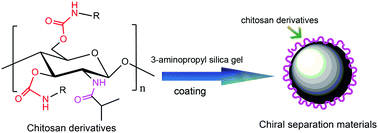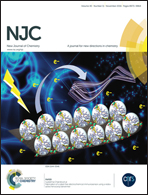Chitosan bis(halophenylcarbamate)-(isobutyrylamide) based chiral stationary phases for enantiomeric separation†
Abstract
The goal of the present study is to systematically investigate the enantioseparation performance and eluent tolerance of chiral stationary phases (CSPs) derived from chitosan bis(halophenylcarbamate)-(isobutyrylamide)s. Hence, N-isobutyrylated chitosan was prepared from completely deacetylated chitosan with a high molecular weight. The N-isobutyrylated chitosan was further derivatized with various halo-substituted phenyl isocyanates, consequently affording a series of chitosan bis(halophenylcarbamate)-(isobutyrylamide)s, which were coated onto 3-aminopropyl silica particles to obtain a class of CSPs. The chiral recognition ability of these CSPs was evaluated with nineteen racemates. It was found that the chitosan bis(halophenylcarbamate)-(isobutyrylamide)s showed powerful enantioseparation performance, and those with 4-chlorophenylcarbamate, 3,4-dichlorophenylcarbamate and 4-trifluoromethoxyphenylcarbamate seemed to exhibit comparable or even more superior enantioseparation ability for the tested racemates in comparison with the well-known derivatives of cellulose and amylose. In addition, the dissolvability and swelling of the prepared chitosan bis(halophenylcarbamate)-(isobutyrylamide)s in organic solvents were discussed in particular. The eluent tolerance of the CSP prepared from chitosan bis(3,4-dichlorophenylcarbamate)-(isobutyrylamide), which exhibited relatively more favorable enantioseparation performance among the prepared CSPs, was investigated. It was observed that the tested CSP could be analyzed with 100% ethyl acetate, 100% chloroform and n-hexane/THF (70/30, volume ratio) without a significant loss of recognition and enantioseparation ability. As a consequence, we can safely draw the conclusion that chitosan bis(halophenylcarbamate)-(isobutyrylamide)s prepared from chitosan with a high molecular weight can show good enantioseparation performance as well as satisfactory eluent tolerance.


 Please wait while we load your content...
Please wait while we load your content...